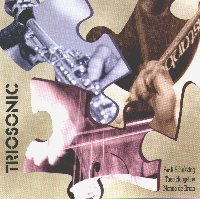Back to index Triosonic | Back
to "About Triosonic"

"Triosonic". A-Records ARP 73089. March 1997.
Ferdi Schukking (saxophones),
Theo Hoogstins (double bass),
Menno de Bruin (drums)
- Octocon (Octotonic construction) is a composition
based on two octotonic scales which are worked up into series according
to the applications of Arnold Schoenberg. By harmonising these into
two seventh chords, a humoristic reference to the blues comes about.
- Lick 'm Broeder (Lick 'm Brother). A 'lickenbroeder'
is someone who rigidly makes use of another man's ideas (licks), carries
these through into perfection, but loses sight of their original meaning
and intensity. The song banters this phenomenon. It is written around
the central A, being an ingredient of twelve chords on each step of
the chromatic scale. The chords have been joined as I-VI-II-V. The
theme evolves around the seventh and the ninth and is based on a number
of 'licks'. The traditional AABA-form is stressed exaggeratedly as
the B-part is being played straight as contrasted with the A-part
which is being played in swing-conception. The B-parts vary in length.
- Expansion is a lofty rubato-melody, supported by a
bowed bass. The drumsolo is violent. It swells draws the soprano into
it. It also doesn't leave the bass alone; plucking heavily, the melody
is driven to a climax.
- The Left-over is based on the third octotonic scale
which we didn't work up in Octocon, so it was left over. A 5/4 bar
crosses the up-tempo. The rock 'n' roll basslick gives the piece a
punky character.
- Visserstraat Blues (Fisherstreet Blues) is a blueslick
played by the bass, which evolves into a 3/4 time. During the improvisation,
the 3/4 time can be played at any given spot. The 14 bar-structure
turns the four round four of the drums into an exciting climax.
- Song 4 C has been dedicated to John Coltrane (1926-1967).
This ballad expresses universal desire. The melody in the high register
of the tenor is drafted with the additions -13 and 14- of the chord.
The scheme modulates from e-flat minor to a minor. The B-part is a
3/4 time.
- 8piral Sequence is a twelve tone series, which, because
of rhythmic variation, gets a different character each time it is
repeated. The cancrisance of the series introduces the solo in which
the musicians use that series as the starting-point.
Up and Go, Libero! Silence is music too. The contrast
between the up-tempo theme and the (up-tempo) silence creates an enormous
tension. The intervals are irregular (2, 3, 4 and 5 bars) and are
continued without a scheme agreed on during the improvisation.
Wind In Rockanje came into being during a performance
on the beach of the Dutch seaside resort Rockanje. The murmur of the
sea is heard in the false air of the tenor. The water babbles through
the two chords of the bass. Is it going to storm?
Thanks is played in swinging 12/8 time. The double bass
starts with the theme: an ostinato figure. With each new start the
tone centre changes and the harmony gets more and more dissonant.
Twice, the theme is being interrupted by a rhythmic pattern -first
in 12/8, the second fime in 7/8-, by which a shift occurs. These are
the ingredients for the soprano and drums. The piece is dedicated
to Steve Lacey who has worked a lot with these forms, structures and
harmonies.
-
- 444 & 453 is a ballad which melody consists of all
twelve tones. The numbers refer to the uee of complementary tetrachords,
which are comparable to the harmolodics of Omette Coleman. The 453
stands for a tetrachord, a pentachced and a very surprising e-minor
triad at the end of the theme.
-
- One can play multiphonics on a saxophone too. With certain grip
combinations and an extremely flexible embouchure (mouth position),
even chords can be brought to sound. Multiphonics is
being played on soprano saxophone; quietly, chromatic, modulating
and back in the beginning, more violent, with dissonants, shrill and
high further on. Vogelvlucht (Bird's-eye View), the
second part, suggests more tones by the rapid arpeggio-movement. The
'circular-breathing'-technique amplifies this effect.
-
- 7th Hour Blues. By projecting a twelve-tone series
-based on the seventh hour of Peter Schat's toneclock- on a minor
blues, a freakish 'lick' arises of which only the last tone affirms
the key. The bariton and the bass solo 'lick for lick' and accompany
the drumsolo with a rhythmic pattern.
-
 Klipzo
is a catchy melody, based on the Caribean Calypso. In the B-part the
theme is being played half a tone higher and shifted one beat (the
beat is reversed). What's more, it doesn't count eight, but seven
bars. Klipzo is a melody to whistle while walking the dog. Klipzo
is a catchy melody, based on the Caribean Calypso. In the B-part the
theme is being played half a tone higher and shifted one beat (the
beat is reversed). What's more, it doesn't count eight, but seven
bars. Klipzo is a melody to whistle while walking the dog.
Go back to index page
|